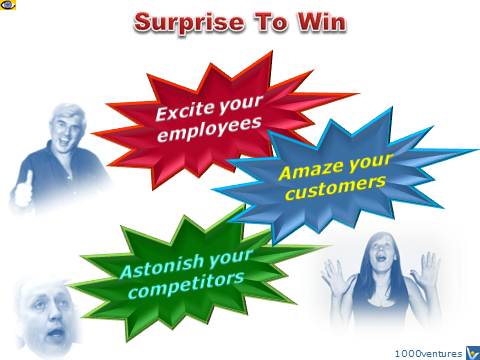
|
Sun Tzu's
"The Art of War" |
-
Warfare is one thing. It is a philosophy of deception.
-
When you are ready, you try to appear incapacitated.
-
When active, you pretend inactivity.
-
When you are close to the enemy, you appear distant....
More
|
|
Fast to Market Tactics1 |
|
"Be
like a duck. Calm on the surface, but always paddling like the dickens
underneath." ~Michael Caine
→
3 Strategies of
Market Leaders
|
|
Staying Beneath the
External Radar
If you fish to get to market fast and/or first,
you must be able to act in secrecy. All
fast-to-market companies demonstrate the ability to
create and prefect
new products in secrecy to stay beneath the radar of their competitors and
to gain a
→
competitive advantage over them.
>>>
In their book It's Not the Big That Eat the
Small... It's the Fast That Eat the Slow,1
Jason Jennings and Laurence Haughton argue that only the swiftest of
corporations will thrive in the 21st century.
→
3Ss
of Winning in Business
Best practices developed by contemporary smart speedsters like
Charles Schwab and AOL,
→
Google, and
→
Facebook can help you outline your own program and work into
you own businesses
by similarly focusing on
→
competitive strategies,
people, and
→
value innovation, and resource
deployment.
To be able to
move faster than your
competition, you must create
environments that
anticipate the future,
reassess operations and personnel and make appropriate adjustments whenever
necessary,
launch a "crusade"
while "staying beneath the radar," and maintain velocity through
institutionalization
of innovation and
close customer
relationships.
 Hotmail Hotmail
Hotmail, the first web-based free e-mail
server, was built around a simple idea.
Sabeer Bhatia and Jack Smith, the
founders of Hotmail, realized that before long the same idea would occur to
many other people. They had to
→
raise venture capital
without revealing the real idea of their business. "I turned over every
stone looking for money. Anyone who would listen, I'd talk to. I pitched
friends, colleagues, classmates, partners, anyone, anywhere, anytime. I
pitched a Texas multimillionaire, an oil magnate, a real estate person, and
even a venture capitalist who funded gas stations," says Sabeer Bhatia. But
he would only reveal the big idea after he was certain he wasn't being
rejected for some irrelevant reason: "All potential investors got the same
pitch – for Java Soft, another program we'd played with. If the person I
started to sell started spouting reasons that I believed were silly ones for
rejecting us, they never got to hear about the real idea. Eventually only 4
people knew about our real plan."
→
8 Key Entrepreneurial Questions
Staying Beneath the
Internal Radar
In
the world of business, most
innovations
have to pass through some kind of deliberate
gatekeeping process that
identifies the likely winners and kills off the variations that serve no
useful purpose. Successful gatekeepers can gather enough resources to
provide “air cover,” allowing the
→
innovation to reside under the radar
screen by protecting it from too much scrutiny during its critical
early
phases.2
 KoRe 10 Innovative
Thinking Tools
KoRe 10 Innovative
Thinking Tools
The
Kore 10 Metaphoric Tools
help you
invent new things,
anticipate market shifts and your opponents' moves, find creative
→
solutions
to a complex problem design
a synergistic innovation
strategy...
More
|